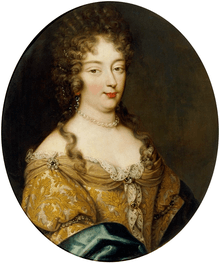Mazarinettes
The Mazarinettes were the seven nieces of Cardinal Jules Mazarin, the Chief Minister of France during the youth of King Louis XIV. He brought them, together with three of his nephews, from Italy to France in the years 1647 and 1653. Afterwards, he arranged advantageous marriages for them to powerful and influential French and Italian princes. To overcome aristocratic resistance to the matches, the cardinal generously granted huge dowries to the fiancés.[1]
The girls were daughters of Mazarin's sisters, Laura Margherita and Geronima:
- Laura Martinozzi (1635–1687), by marriage with Alfonso IV d'Este, Duchess of Modena and Reggio since 1658
- Laura Mancini (1636–1657), by marriage with Louis de Bourbon, Duchess of Mercœur since 1651
- Anne Marie Martinozzi (1637–1672), by marriage with Armand de Bourbon, Princess of Conti since 1654
- Marie Mancini (1639–1715), by marriage with Lorenzo Onofrio Colonna, Princess Colonna since 1661
- Olympia Mancini (1640–1708), by marriage with Eugène Maurice of Savoy, Countess of Soissons since 1657
- Hortense Mancini (1646–1699), by marriage with Armand Charles de La Porte de La Meilleraye, Duchess Mazarin since 1661
- Marie Anne Mancini (1649–1717), by marriage with Godefroy Maurice de La Tour d'Auvergne, Duchess of Bouillon since 1662
- Portraits
 Laura Martinozzi
Laura Martinozzi Laura Mancini
Laura Mancini Anne Marie Martinozzi
Anne Marie Martinozzi Marie Mancini
Marie Mancini Olympia Mancini
Olympia Mancini Hortense Mancini
Hortense Mancini%2C_Duchess_of_Bouillon_by_Benedetto_Gennari.jpg) Marie Anne Mancini
Marie Anne Mancini
Arriving in France at different times, the girls were aged between seven and thirteen years old at the time of their arrival. Their uncle, Cardinal Mazarin, had requested their presence at the French court for several reasons. First, he was tired of being surrounded by French nobles and courtiers he could not trust. He wanted to be able to relax around and confide in members of his own family. Second, he wished to use his nieces and nephews to consolidate his legacy in French society and history. As a cleric, he had no legitimate children with which to do that.
Upon their arrival in Paris, Anne of Austria, the mother of the young king, Louis XIV, took the children under her wing. She even allowed the younger ones to be educated together with the king and his younger brother, Philippe, in the Palais-Royal. With this mark of favour, she placed the young ladies on the same level as the princesses of the blood.
When the girls were first officially presented at court, Marshal Villeroy said to the king's uncle, Gaston, Duke of Orléans:
"Voilà des petites demoiselles qui présentement ne sont point riches, mais qui bientôt auront de beaux châteaux, de bonnes rentes, de belles pierreries, de bonne vaisselle d'argent, et peut-être de grandes dignités […]"[2]
("Here are young ladies who just at present are not rich at all, but who soon shall have beautiful castles, good incomes, precious stones, substantial silver plate, and per chance great rank […]"[3]).
In Paris, the Mazarinettes caused quite a stir because of their appearance. In a milieu where pale skin and a full figure were regarded as the established ideal of beauty, the girls' darker Italian complexions and slight builds were much remarked upon.[4]
One of the so-called Mazarinades, satires and pamphlets against Mazarin that were very numerously published in France between 1648 and 1653, described the cardinal's nieces as follows:
| French original | English translation |
|---|---|
|
Elles ont les yeux d'un hibou, |
They possess the eyes of an owl, |
Other Mazarinades called them "dirt princesses" and "stinking snakes".[5]
As protegées of their uncle, the girls' lives often reflected the cardinal's variable fortunes. During the Fronde, they twice were forced to leave Paris and go into exile. After the revolt was crushed, though, Cardinal Mazarin secured for them all a life of carefree prosperity by finding them suitable husbands and showering lavish wedding gifts upon them.
Notes
- ↑ Jurewitz-Freischmidt, Sylvia (2002). Galantes Versailles. Die Mätressen am Hofe der Bourbonen (in German). Munich: Piper. p. 20. ISBN 978-3-492-24494-7.
- ↑ Renée, Amédée (1856). Les nièces de Mazarin: Études de mœurs et de caractères au XVIIe siècle (in French). Paris: Firmin Didot. p. 37. Retrieved October 15, 2009.
- ↑ Savoie-Carignan, Guy Jean Raoul Eugène Charles Emmanuel de (1911). The seven richest heiresses of France. London: J. Long. p. 64. Retrieved October 15, 2009.
- ↑ Guth, Paul (1973). Mazarin. Frankreichs Aufstieg zur Weltmacht (in German). Frankfurt: Societäts-Verlag. p. 638.
- ↑ Guth, Paul (1973). Mazarin. Frankreichs Aufstieg zur Weltmacht (in German). Frankfurt: Societäts-Verlag. p. 639.
References
- Combescot, Pierre (1999). Les petites Mazarines (in French). Paris: Grasset. ISBN 2-246-47761-1.
- Guth, Paul (1973). Mazarin. Frankreichs Aufstieg zur Weltmacht (in German). Frankfurt: Societäts-Verlag. pp. 637–670.
- Hillairet, Jacques (1976). Les Mazarinettes ou, Les sept nièces de Mazarin (in French). Paris: Éditions de Minuit. ISBN 2-7073-0138-8.
- Renée, Amédée (1858). Die Nichten Mazarin's. Studien der Sitten und Charaktere im 17. Jahrhundert (in German). Dresden: Rudolf Kuntze. Retrieved October 15, 2009.
- Saint-Victor, Paul de (1867). "Les Mazarines". Revue du XIXe siècle. 4: 323–331.
- Savoie-Carignan, Guy Jean Raoul Eugène Charles Emmanuel de (1911). The seven richest heiresses of France. London: J. Long. Retrieved October 15, 2009.